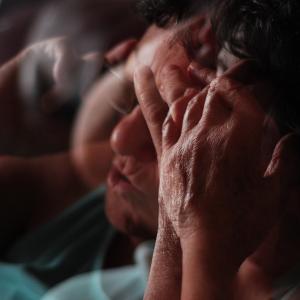Life expectancy at birth improved from 59.7 years in 1990 to 70.3 years in 2016 for women.

Indians have gained nearly a decade of life expectancy since 1990, women more so than men, a first of its kind study released on Tuesday has revealed.
But that is a rare bit of good news as India faces a severe lifestyle crisis, with its disease burden from communicable diseases such as diarrhoea and tuberculosis to non-communicable diseases like heart disease and diabetes, the study has found.
Worse, this health crisis is characterised by widening disparity between India's relatively more prosperous and poorer states and can potentially impair its demographic dividend.
Life expectancy at birth improved from 59.7 years in 1990 to 70.3 years in 2016 for women.
For men, life expectancy increased from 58.3 years to 66.9 years.
But here again, state level inequalities are stark, with a range of 66.8 years in Uttar Pradesh to 78.7 years in Kerala for women, and 63.6 years in Assam to 73.8 years in Kerala for men in 2016, the report said.
The first state-level disease burden and risk factors estimates to improve health and planning for every state in India is a collaborative work by the Indian Council of Medical Research (ICMR), the Public Health Foundation of India (PHFI), the Institute for Health Metrics and Evaluation (IHME) and the Union Ministry of Health and Family Welfare.
The researchers divided India's states into four groups according to their level of development or epidemiological transition, using the ratio of illness and premature death caused by communicable, maternal, neonatal, and nutritional diseases (CMNNDs) versus non-communicable diseases (NCDs) and injuries as an indicator.
India is undergoing a major epidemiological transition in consonance with social and economic development.
Contribution of communicable diseases to deaths in India reduced from 53.6 per cent to 27.5 per cent, while that of NCDs rose from 37.9 per cent to 61.8 per cent, the study says.
India's disability adjusted life years, or DALYs -- one combined measure of the health loss burden taking into account both premature mortality and disability -- from communicable diseases reduced from 60.9 per cent of the total DALYs to 32.7 per cent, while DALYs from NCDs rose from 37.9 per cent to 61.8 per cent.
It found that three of the five leading killers in India in 2016 were NCDs -- ischaemic heart disease, chronic obstructive pulmonary disease and stroke.
Unveiling the study in Gurugram, Vice-President M Venkaiah Naidu said the findings show that the overall disease burden per person in some states of India was almost twice as much as in some other states, and the burden rate due to the leading diseases ranges from five to ten times between the states.
"The specific disease burden trends for each state in this report provide a reference for planning interventions that are needed to address the major disease problems in each state," he said.
Some of the more prosperous states like Goa, Tamil Nadu and Kerala contribute the largest share of NCDs.
These include diabetes, chronic respiratory diseases, mental health and neurological disorders, cancers, cardiovascular diseases, chronic kidney diseases and musculoskeletal disorders.
In contrast, malnutrition continues to be a curse in some of the poorer states, also called the Empowered Action Group (EAG), like Chhattisgarh, Bihar, Madhya Pradesh, Jharkhand, Rajasthan, Odisha, Uttarakhand, Uttar Pradesh and Assam. It found a higher incidence of malnutrition among women.
For instance, Punjab could rightly be called the heart attack capital of India, with the highest deaths per 100,000 population at 261. Relatively under-developed Odisha has a rate of 72. On the other hand, Odisha shows the worst death rate among diarrhoea diseases at 129, while Punjab does well at 34.
The report also notes that under-five mortality rate has decreased significantly in all states. But, in the states that recorded the highest number of such mortalities, such as Assam and Uttar Pradesh, the rates were four times that of the states with the lowest incidence, such as the relatively more prosperous Kerala.
The report states that India has made substantial gains in health since 1990, with the overall health loss from all diseases and conditions about one-third less per person in 2016. But, progress has been mixed.
Lower respiratory infections and diarrhoea diseases were the third and fourth leading causes of health loss in 2016, accounting for about nine per cent of all premature death and ill health. But there are wide differences between states in terms of overall progress.
Despite signs of progress, diarrhoea diseases, iron-deficiency anaemia, and tuberculosis still cause a disproportionate amount of ill health, and claim more lives, than is expected for India's stage of development, particularly in states in the early stages of epidemiological transition.
The report used data from censuses, large-scale national household surveys, disease surveillance data, and administrative records of health services, disease registries, and a wide range of other health studies conducted across India.
The burden from 333 diseases and injuries and 84 risk factors were computed for each state as part of the Global Burden of Disease Study 2016.
It found that the fastest-growing causes of ill health over the past 26 years were diabetes (increased by 174 per cent) and ischaemic heart disease (up 104 per cent).
Rapid urbanisation is responsible for rising deaths and health loss from road injuries in most states since 1990, highlighting the lack of a comprehensive national policy for injury prevention, researchers said.
"The results show that the burden due to non-communicable disease and injuries has overtaken the burden due to infectious and maternal-child diseases in every state of India, though this happened in some states about three decades ago and in other states more recently," Union Health Minister J P Nadda said. He said the more developed states that had this transition a long time ago need to go on a war footing to control the rapidly rising burden of major NCDs and injuries.
"The contribution of non-communicable diseases to health loss, fuelled by unhealthy diets, high blood pressure, blood sugar and overweight, has doubled in India over the past two decades. Air pollution and tobacco smoking continue to be major contributors to health loss,” said Dr K Srinath Reddy, president, PHFI.
Lead photograph used for representational purpose only. Kind courtesy: StockSnap/Pixabay.com










